Anna Philips-de Jongh (1878-1970)
A pioneer of social welfare
"I hope I have done something to contribute towards the happiness of people." From the very first days after her marriage to Anton Philips in 1898, Anna Philips-de Jongh felt involved in the development of the company. She accompanied her husband on many of his business trips, advised him in business matters, and worked for the welfare of the employees, especially the female workers. Her activities were not limited to Philips; she also showed a great deal of interest in the community outside the company.
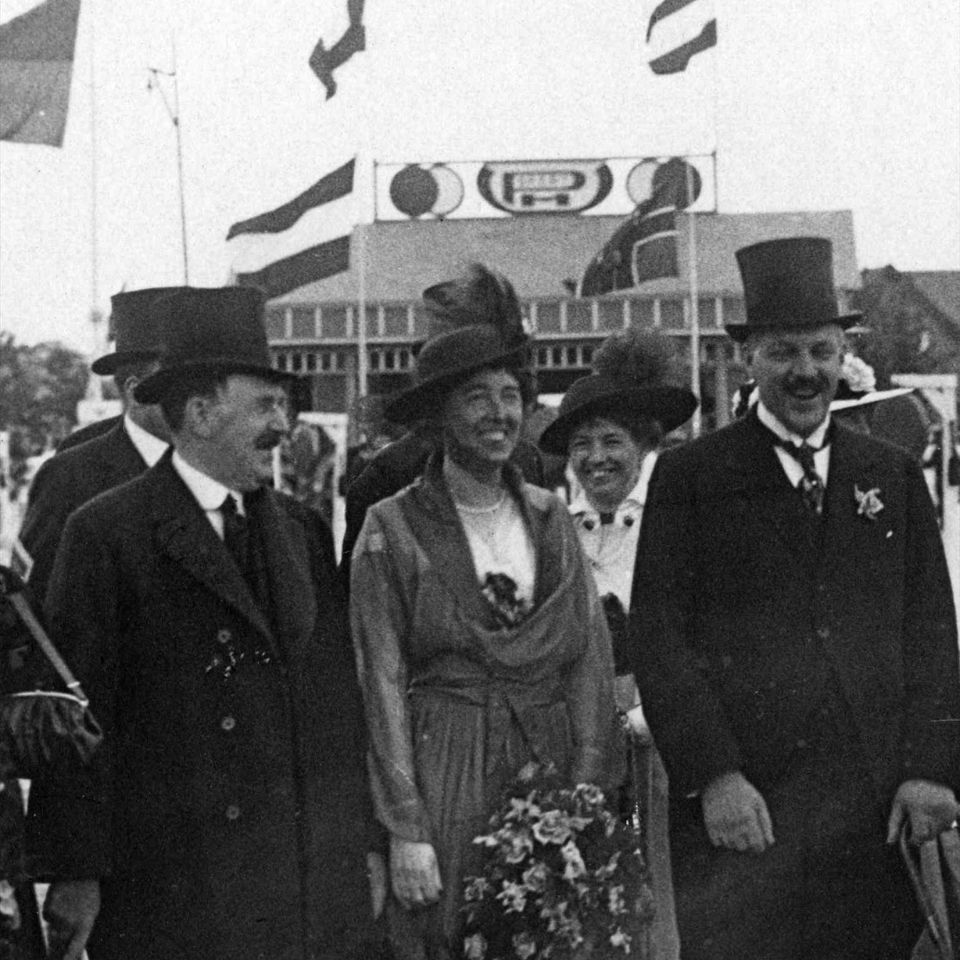
Anna Philips-de Jongh during the 25th jubilee festivities in 1916. Left is Gerard Philips (the founder of the Philips company) and right is Anton Philips.
Work for the Red Cross
In 1909, Anna was one of the founders of the local Red Cross society and served as its president, for an impressive 22 years, from 1914 to 1936. During World War I, thousands of refugees from Belgium and France arrived in Eindhoven, seeking shelter in the neutral Netherlands. Anna managed the smoother movement of these refugees by establishing the transport service in 1914. In 1915, she organized the medical care service for wounded soldiers, set up training programs for nurses and helped establish emergency hospitals. This was crucial because several contagious diseases, such as scarlet fever, diphtheria, and severe flu, broke out among the refugees.
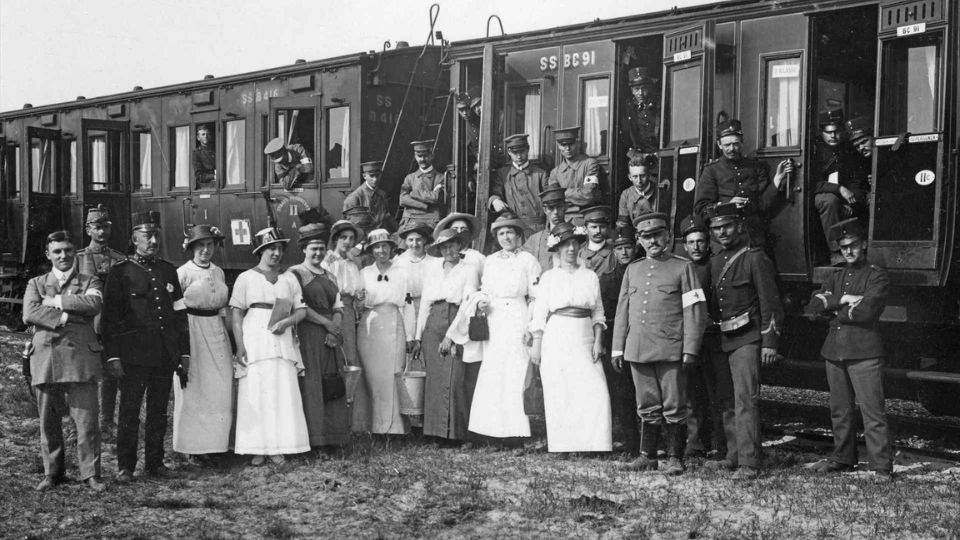
The Red Cross society helping Belgian refugees during World War I (1914). Anna Philips-de Jongh stands in the middle.
On October 17, 1914, Anton Philips wrote to their eldest daughter: “Mom was all day on the go, from early morning till two o’clock at night, feeding all these unfortunate people, providing a place to sleep, etcetera, etcetera”. Anna also opened part of their private home ‘The Laak’ to provide more shelter and care of refugees and wounded soldiers. The residents of Philipsdorp (Philips Village) followed her example. Some refugees and soldiers found work at the Philips factories. Anna Philips remained very much involved in the work of the Red Cross for the rest of her life. After the war she was responsible for the further professionalization of the local Red Cross organization. On her initiative, the blood transfusion service was established in 1933. For her contributions, she was given several recognitions. She also received the Red Cross Government Medal, a rare and prestigious award.
Care for Young Mothers
Anna supported the establishment of the Philips Medical Service in 1909, which is considered the cradle of occupational medicine in the Netherlands. From 1910 onwards the workforce was able to receive free medical care in Philips’ own fully equipped outpatients’ clinic. Her efforts also extended beyond Philips in improving healthcare, especially mother and child care. At that time, infant mortality rates in Eindhoven and surrounding areas were very high. Anna's initiative to change this situation proved successful. Thanks to her personal financial contribution, the District Nursing Association for Eindhoven and surrounding municipalities was founded in 1912 providing free services. In 1915, midwifery and postnatal care services started, followed by the opening of a free Consultation Bureau for Infant Welfare in 1923. The results were immediate, with infant mortality rates dropping significantly.

Mothers with their children standing at the Child Health Clinic (1921). This Clinic was located opposite the first Philips factory (now Philips Museum) at the Emmasingel.
Pioneer in Domestic Education
During her visits to the factories, Anna noticed that young women were not prepared to run their own households efficiently. In May 1917, she established courses for female factory workers in cooking, sewing and mending. The courses were later expanded and included washing, ironing, household management, and first aid. The lessons took place in the evenings. A modest fee was charged for participation, but the materials were free. Anna assisted with purchasing equipment and supervised the curriculum. She regularly reviewed the exam pieces, and she was always present when certificates were awarded to successful students.
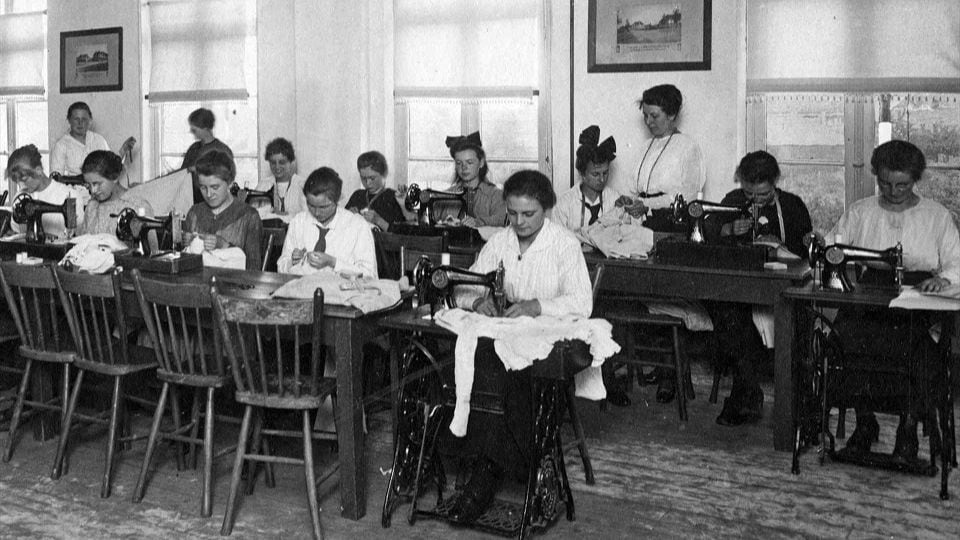
Sewing and mending lessons (1917)

Cooking class (1943)
The courses proved hugely popular, with thousands of young women taking advantage of them. Numerous thank-you letters to Anna bear witness to their success. By 1923, the classes had grown so much that the Philips Domestic Science School was established.
Recreation, Culture, and Sports
"Mother was musical, played the piano well, and made music regularly," said Frits Philips about his mother Anna Philips-de Jongh. Anna chaired the Committee for Organizing Chamber Music Concerts in Eindhoven and strived to bring good artists to the city. For a long time, these concerts were the only opportunity to hear chamber music in Eindhoven. Anna regularly played music with her husband Anton at ‘The Laak’. She also enjoyed painting and was very sporty. Swimming, skating, playing tennis, cycling, and horseback riding were some of her favorite activities. She loved taking walks through the nature of Brabant region and played golf until the age of 84. Anna believed that relaxation was essential for the well-being of the employees, both culturally and sportively. She helped arrange staff events during factory holidays. In 1922, she opened a playground for the children in Philipsdorp (Philips Village), which was only the third in the Netherlands at the time.
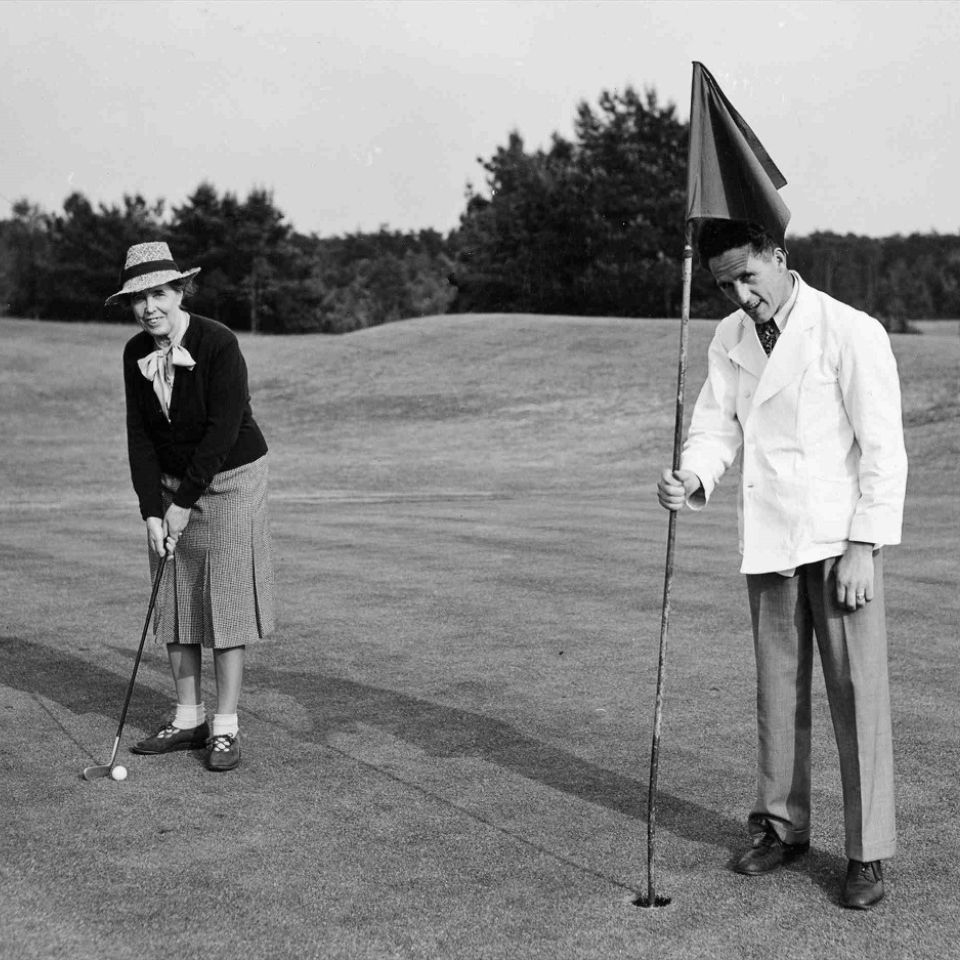
Anna Philips-De Jongh playing golf at the Eindhovensche Golf course (1948)
Her efforts to organize cultural and sports activities led to the donation of the Philips-de Jongh Park to the residents of Eindhoven in 1920, the founding of the Philips-de Jongh Recreation Fund in 1921, and the opening of the Philips Recreation Center in 1929.
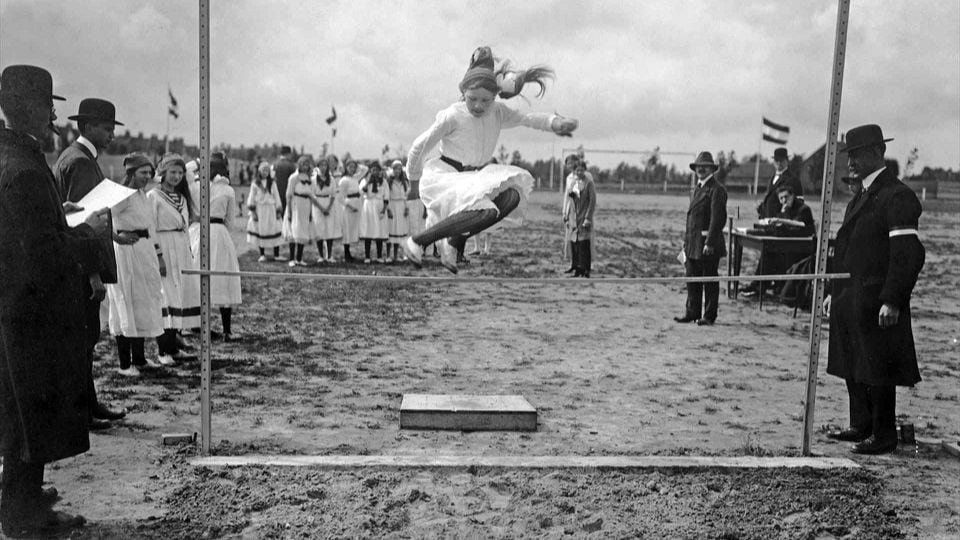
Independence celebrations in 1913, Strijp Eindhoven sports ground (later Philips Sports Park) (1913)
The Philips Recreation Center featured a reading room, library, billiard room, cinema, theater, and various club rooms. The Philips-de Jongh Recreation Fund encouraged many types of recreation. These included sport activities, nature walks, and cycling. The fund also supported music events and hobby clubs, ranging from chess to flower arranging courses. For her meaningful contributions to social welfare, Anna Philips-de Jongh received one of the highest honors, Knight in the Order of the Netherlands Lion, in 1951. In her acceptance speech, she humbly stated, "I hope I have done something to contribute towards the happiness of people."
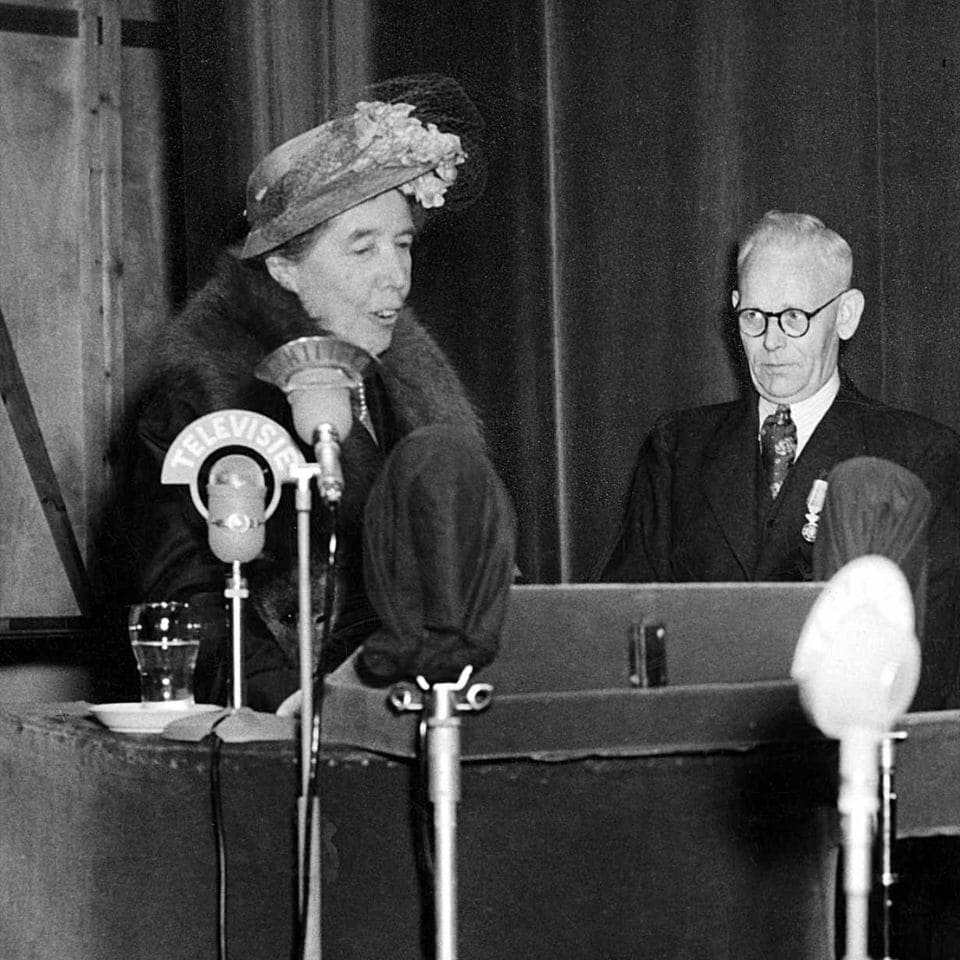
Anna Philips-de Jongh gives a speech upon receiving the Order of the Netherlands Lion (1951)
Anna Philips-de Jongh was born on May 30, 1878, and grew up in the rapidly expanding Rotterdam of the late 19th century. Her father, Gerrit de Jongh, was the city engineer and one of the founders of the present world port in Rotterdam. After completing her secondary education, Anna spent time in England and Switzerland to broaden her language skills. In 1896, she met Anton through her brother, engineer Marcel de Jongh, who was supervising the construction of the tram line between Eindhoven and Reusel. The blueprint for what would later be known as Philipsdorp (Philips Village) was designed by her father, Gerrit de Jongh. From the very first day of her marriage to Anton Philips in 1898, Anna Philips-de Jongh has been deeply involved in the development of the company, particularly in social policy.
Text: Miriam Lengová, Philips Company Archives Source: Philips Company Archives Copyright: Koninklijke Philips N.V.

